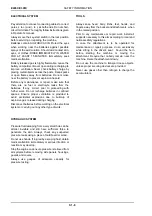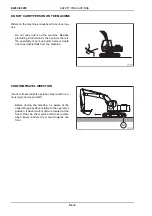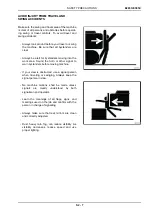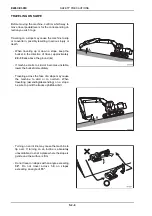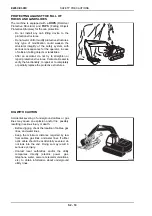
E265C-E305C
SAFETY INFORMATION
S1 - 4
- Contact the company owner of the gas mains or its
nearest branch before starting the work.
- Define together which precautions should be taken
to guarantee work safety.
- Decrease work speed. Reaction time could be too
slow and distance evaluation wrong.
- When working near gas mains or other public
utilities installations, appoint a person in charge of
signalling duties. This person will have the
responsibility of observing the machine, any part of
it and/or the load approaching the gas mains from
a standpoint more favorable than the Operator.
This signal man (flag-man) must be in direct
communication with the Operator and the Operator
must pay undivided attention to the signals
supplied.
- The gas distributing Company, if previously
advised and involved in the work, as well as
machine Operator, Owner and/or any natural
person or legal entity having rent or leased the
machine or being responsible at the time by
contract or by law, are liable for the adoption of the
necessary precautions.
Working near electric lines can be very dangerous,
therefore some special precautions must be
observed.
Within this Manual, “work near electric lines” means
when the attachment or load raised by the excavator
(in any position) may reach the minimum safety
distance established by local or international Safety
Regulations.
To work without risks, keep maximum possible
distance from electric lines and never trespass
minimum safety distance.
- Contact the Company owner of the electric lines or
its nearest branch before starting the work.
- Define together with the Company representative
which precautions should be taken to guarantee
work safety.
- All electric lines should be considered as operative
live lines even though it might be well known that
the line in question is out of work and visibly
connected to the ground.
- The Electric Power Company, if previously advised
and involved in the work, as well as machine
Operator, Owner and/or any natural person or legal
entity having rent orleased the machine or being
responsible at the time by contract or by law, are
liable for the adoption of the necessary
precautions.
- Decrease work speed. Reaction time could be too
slow and distance evaluation wrong.
- Warn all ground personnel to keep clear of the
machine and/or load at all times. If the load has to
be guided down for laying, consult the Electric
Power Company to know which precautions should
be taken.
- Appoint a person in charge of signalling duties.
This person will have the responsibility of observing
the machine, any part of it and/or the load
approaching the electric lines from a standpoint
more favorable than the Operator. This signal man
(flag-man) must be in direct communication with
the Operator and the Operator must pay undivided
attention to the signals supplied.
When working in or near pits, in ditches or very high
walls, check that the walls are sufficiently propped up
to avoid cave-in hazards.
Pay the utmost attention when working near
overhang walls or where landslides may take place.
Make sure that the support surface is strong enough
to prevent landslides.
When digging, there is the risk of cave-ins and
landslides.
Always check ground conditions and conditions of
the material to be removed. Support everywhere it is
required to prevent possible cave-ins or landslides
when:
- Digging near previous trenches filled with material.
- Digging in bad ground conditions.
- Digging trenches subject to vibration from
railroads, working machines or highway traffic.
STOPPING
When the machine is to be stopped for whatever
reason, always check that all controls are in the
neutral position and that the safety lever is on the lock
position to guarantee risk-free start-up.
Never leave the machine unattended with the engine
running.
Prior to leaving the driver’s seat, and after making
sure that all people are clear of the machine, slowly
lower the attachment until resting it safely to the
ground. Retract possible auxiliary tools to the closed
safety position.
Check that all controls are in the neutral position.
Move engine controls to the shut-down position.
Switch off the key-start switch.
Park the machine in a non-operating and no-traffic
area. Park on firm level ground. If this is not possible,
position the machine at a right angle to the slope,
making sure there is no danger of uncontrolled
sliding.
If parking in traffic lanes cannot be avoided, provide
appropriate flags, barriers, flares and other signals as
required to adequately warn the oncoming drivers.
Always switch off the key-start switch before
cleaning, repairing, or parking the machine to prevent
accidental unauthorised start-up.
Never lower the attachment or auxiliary tools other
than from sitting in the operator’s seat. Sound the



















